What is Japanese Minimalism?
Japanese minimalism is a design and lifestyle movement with roots in Japan. It is distinguished by a purposeful focus on utility, simplicity, and thoughtful use of space. Japanese minimalism has its roots in traditional Japanese aesthetics and is primarily inspired by Zen Buddhism and the idea of wabi-sabi. Its goal is to create surroundings that are orderly, peaceful, and functional. Beyond just design principles, the concept affects many facets of daily life, promotes purposeful living, and cultivates a profound appreciation for the beauty found in imperfection and simplicity.
Functional design, respect for empty space, the use of natural materials, a neutral color palette, a dedication to decluttering, and thoughtful consumption are all fundamental elements of Japanese minimalism. It is a holistic approach that goes beyond aesthetics, reflecting a profound cultural and philosophical connection to the essence of life and living spaces.
Marie Kondo is like the queen of decluttering and organization. She’s a Japanese organizing consultant and the author of the super popular book, “The Life-Changing Magic of Tidying Up.” Her whole deal is about sparking joy and getting rid of stuff that doesn’t make you happy. When she said once
“Does it spark joy?”
So, imagine you’ve got this old, beat-up hoodie from high school. It’s got holes, the color is fading, but it holds sentimental value. According to Marie, if that hoodie sparks joy, keep it. But if it just reminds you of a time you’d rather forget, maybe it’s time to let it go.
Let’s have Your Example: You know that mug your friend gave you ages ago? If every time you use it, you’re reminded of that amazing day you spent together, that’s sparking joy. But if it’s just taking up space and you can’t remember why you have it, maybe it’s time for it to find a new home.
RELATED BLOG: 18 GENIUS LINEN CLOSET ORGANIZATION HACKS TO SAVE TIME
What is Japanese Minimalism Theory?
1. Simplicity and Elegance: The Dance of Essentials
Japanese minimalism, at its core, champions the pursuit of simplicity and elegance. It’s an artful curation that involves shedding the superfluous to reveal the essence. Honestly speaking, this is not a mere aesthetic choice; it’s a deliberate act of paring down to the fundamentals. TBH, the beauty lies in the uncluttered canvas where each element is purposefully placed, creating a visual poetry that resonates with tranquility and grace.
Like when Marie Kondo said:
“When people revert to clutter no matter how much they tidy, it is not their room or their belongings but their way of thinking that is at fault.”
2. Functional Design in Japanese Minimalism
Functionality is the heartbeat of Japanese minimalism. Every item, whether a piece of furniture, article of clothing, or tool, is a manifestation of purpose. In this realm, form follows function with an unwavering commitment to practicality and efficiency. Honestly speaking, it’s not just about appearances; it’s about items seamlessly integrating into daily life, each telling a purposeful narrative. It’s a dance where every movement serves a purpose, a symphony of design in the key of functionality.
3. Appreciation for Space: Embracing the Empty Spaces
In the canvas of Japanese minimalism, empty space is a masterpiece in itself. The concept of “Ma,” the beauty of negative space, is pivotal. The more space is empty the more it will help you to focus. It’s an acknowledgment that space is not a void but a presence, a breath that allows for calmness and balance. It’s about embracing the emptiness with the same reverence as the objects it surrounds. Honestly speaking, it’s the interplay of substance and void that creates a visual melody, echoing the Zen philosophy.
As Tadao Ando said:
“I don’t believe architecture has to speak too much. It should remain silent and let nature in the guise of sunlight and wind.”
4. Natural Materials: Soothe Your Soul

Bringing the outdoors in by incorporating materials like wood, stone, and bamboo into our living spaces isn’t just about making things look pretty – it can actually do wonders for our health and well-being! Picture walking into a room with a wooden floor, maybe some stone accents, or bamboo furniture – it’s like a mini nature retreat in your home. These natural materials have the amazing ability to create a sense of warmth, calmness, and connection to the Earth.
They’re not just pleasing to the eye; they contribute to a healthier atmosphere too. Wood, with its cozy vibe, has been linked to reduced stress levels, while stone’s cooling effect can be refreshing in warm weather. Bamboo, being sustainable and flexible, adds an eco-friendly touch. Beyond aesthetics, these materials create spaces that feel comfortable, reduce noise, and even promote a better mood. So, it’s not just about style – it’s about making our homes little havens for our well-being.
5. Mottainai Philosophy
The concept of “mottainai” is a Japanese term expressing a sense of regret over wasting something useful. This philosophy aligns with the minimalistic idea of mindful consumption and reducing waste. It encourages individuals to appreciate and utilize items fully, fostering a sustainable and environmentally conscious lifestyle.
6. Limited Color Palette: Tranquility in Japanese Minimalism
The color palette in Japanese minimalism is a deliberate composition of tranquility. Subdued and neutral tones like white, beige, and muted earthy colors dominate. It’s not about the absence of color but a purposeful selection that contributes to the overall serenity. Honestly speaking, the limited palette is a conscious choice to soothe the senses, creating an environment that speaks softly yet profoundly.
7. Clutter-Free Living: Embracing Essentialism

Decluttering is a sacred ritual in Japanese minimalism. It’s not just about tidying up; it’s a profound practice of surrounding oneself with the essentials. Honestly speaking, it’s a journey of liberation from the weight of unnecessary possessions. It extends beyond physical spaces, permeating into the mental landscape, and fostering a sense of calm and clarity.
As Marie Kondo said:
“Tidy a little each day, and you’ll be tidying forever.”
Marie is all about making tidying up a habit. Instead of having these epic cleaning sessions once in a blue moon, she suggests doing a bit every day to keep things in check.
RELATED BLOG : HOW TO ORGANIZE ENTRYWAY WITHOUT A CLOSET? 10 HACKS TO MAKE LIFE EASY
8. Wabi-Sabi: Celebrating Imperfection
9. Multi-Functional Spaces: Adapting with Grace
In the dance of Japanese minimalism, spaces are not rigid but adaptive. Furniture and rooms are designed to serve multiple purposes, promoting efficiency and adaptability. TBH, it’s about living with intention, where every element has a role to play. Honestly speaking, it’s a dance floor where versatility takes center stage, allowing spaces to evolve harmoniously with the changing rhythms of life.
10. Ikebana (Flower Arranging)
Ikebana, the Japanese art of flower arranging, is deeply rooted in minimalism. The practice involves arranging flowers and other elements in a simple yet meaningful way. Ikebana emphasizes the beauty of space and the importance of each element in the arrangement, embodying the principles of minimalism in an artistic form.
11. Mindful ConsumptionFor Japanese Minimalism
Mindful consumption is the beating heart of Japanese minimalism. It’s a conscious shift from pursuing excess to cherishing meaningful acquisitions. TBH, it’s not about having less but having with purpose. It’s a journey of discernment, valuing quality over quantity, and finding joy in the essentials that align with one’s authentic self.
12. Zen at the Core
The principles of Japanese minimalism draw deeply from the well of Japanese culture and philosophy, especially Zen Buddhism. Mindfulness, simplicity, and a profound connection to nature are not just design elements but guiding lights. It’s a cultural symphony where each note resonates with centuries of wisdom. It’s not a trend but a timeless expression of a profound way of being.
-
Mushin (Mind of No-Mind)
Mushin is a concept deeply ingrained in Japanese martial arts and Zen philosophy. Translating to “mind of no mind,” it refers to a state of mental clarity, focus, and presence without distraction. This principle extends beyond the martial arts realm and aligns with Japanese minimalism by emphasizing the importance of decluttering the mind, living in the moment, and appreciating simplicity in all aspects of life.
13. Tea Ceremony (Chanoyu/Chado)
The Japanese tea ceremony, known as Chanoyu or Chado, is a ritualistic practice deeply rooted in Zen philosophy. This minimalist approach to the preparation and consumption of tea involves precise movements, simple utensils, and a focus on the present moment. The tea ceremony exemplifies the beauty found in simplicity, emphasizing the significance of mindfulness and the appreciation of small, meaningful gestures.
FAQs
What are the rules of Japanese minimalism?
- Simplicity is Key:
- Japanese minimalism revolves around simplicity in design and function. It’s about paring down to the essential elements, avoiding unnecessary embellishments, and creating a clean, uncluttered aesthetic.
- Embrace Empty Spaces (Ma):
- The concept of “ma” highlights the importance of appreciating empty spaces. It’s not about leaving things blank but recognizing that these spaces contribute to a sense of balance and harmony within the design.
- Natural Materials and Colors:
- Japanese minimalism favors the use of natural materials like wood, stone, and bamboo. The color palette tends to be neutral, creating a connection to nature and promoting a calming and timeless atmosphere.
- Functionality Over Ornamentation:
- Functionality takes precedence over decorative elements. Every item should serve a purpose, and the design should enhance the usability of the space, promoting efficiency and practicality.
- Mindful Consumption:
- Minimalism extends to lifestyle, emphasizing mindful consumption. Rather than accumulating excess, the focus is on appreciating and taking care of what one has, promoting a more intentional and sustainable way of living.
- Wabi-Sabi Aesthetic:
- Wabi-Sabi celebrates imperfections, transience, and the beauty of the patina that comes with age. It encourages an appreciation for the uniqueness found in the imperfect and embraces the natural cycle of growth and decay.
- Zen Influence:
- Zen philosophy plays a significant role, in encouraging mindfulness, simplicity, and being present in the moment. The design reflects a sense of calmness and tranquility, promoting a harmonious living environment.
What are Japanese minimalism ideas?
Japanese minimalism is like the magic wand that turns your living space into a serene haven. It’s all about keeping things simple and functional, stripping away the unnecessary to let the true essence of a design shine through. Think clean lines, open spaces, and a cozy vibe that comes from using natural materials like wood, stone, and bamboo. It’s not just about having less stuff; it’s about having the right stuff – things that bring joy and purpose.
Japanese minimalism is a lifestyle too, nudging us to be mindful consumers, appreciating what we have, and finding beauty in the imperfect. It’s like a peaceful Zen garden for your home, where each item has a story, and the whole space whispers tranquility. So, less clutter, more calm – that’s the heart of Japanese minimalism.


